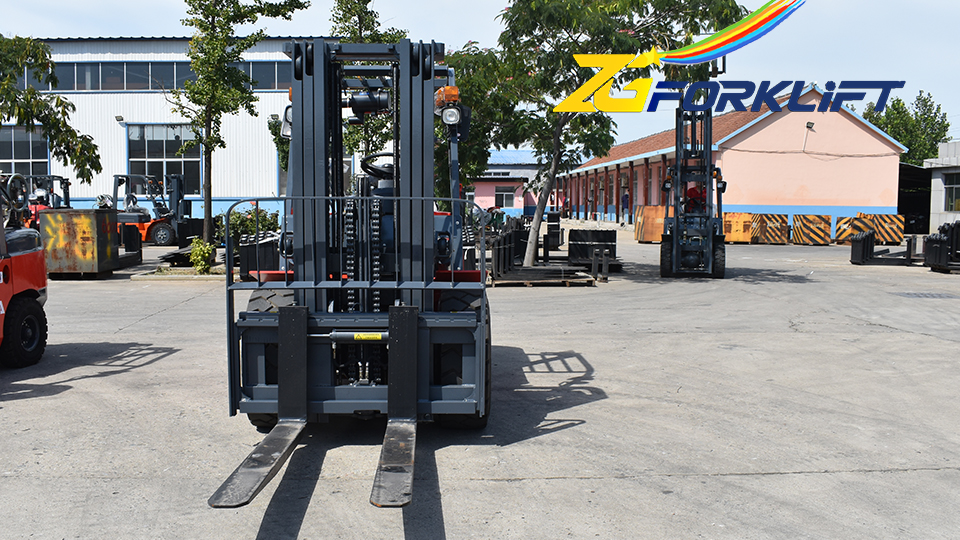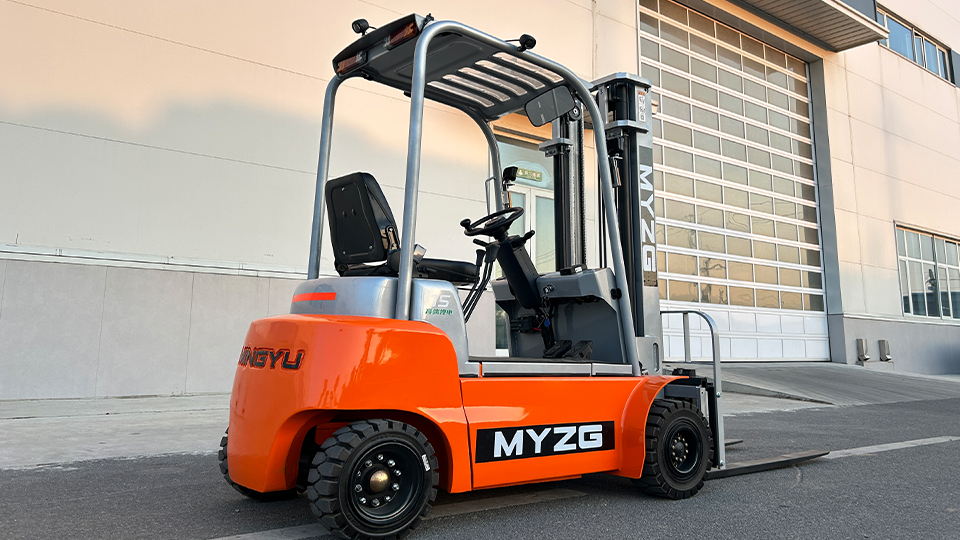
A Technical Guide to the Installation of Forklift Tires: The Press-On Procedure
The process of replacing tires on certain classes of powered industrial trucks, specifically those utilizing Cushion (Press-On) Tires and many types of Solid Pneumatic Tires, is a specialized operation that requires the use of a high-tonnage hydraulic press. Unlike standard pneumatic tires, which rely on internal air pressure to seat the tire on a multi-piece rim, press-on tires are a solid rubber compound permanently bonded to a steel band (or wheel hub) and must be mechanically forced onto or off a wheel assembly.
This technical article will detail the machinery, preparatory steps, critical safety protocols, and precise methodology required to safely and effectively press on replacement forklift tires, adhering to industry best practices for industrial maintenance and material handling equipment.

1. Understanding Press-On Forklift Tires and Equipment
Before beginning the process, it is crucial to understand the construction of the tires and the capabilities of the required machinery.
A. Types of Tires Requiring Pressing
Cushion/Press-On Tires: These are solid rubber tires molded onto a steel band (the ring) that are then pressed onto the wheel hub. They are designed for smooth, indoor surfaces and offer a low profile, increasing the forklift’s stability and maneuverability. They are typically found on Class I (Electric Motor Rider), Class IV (Internal Combustion Engine, Cushion Tire), and some Class V (Internal Combustion Engine, Pneumatic Tire) forklifts.
Solid Pneumatic Tires (Some Types): While some solid pneumatic tires are mounted on traditional multi-piece rims, many require a press to seat the tire tightly onto a split rim or to assemble a multi-piece rim component (e.g., side ring, lock ring, base). The high density of the solid rubber prevents traditional manual mounting techniques.
B. The Hydraulic Tire Press (The Cornerstone Tool)
The heart of the tire replacement operation is the hydraulic tire press. This machine is a vertical or horizontal hydraulic ram capable of generating enormous forces, typically ranging from 150 to over 250 tons of pressure.
Function: To overcome the friction and compression forces inherent in the steel-to-rubber bond and mechanically force the steel band of the tire off the wheel hub, and subsequently force the new tire's band onto the hub.
Accessories: The press utilizes specialized tooling, including:
Adapter Plates/Support Plates: Base components for centering and stabilizing the wheel assembly.
Disassembly Cones/Rings: Used to locate the wheel hub and protect the bearing seats during the pressing operation.
Push Rods/Plates: Attachments used to transmit the hydraulic force directly to the tire band.
2. Safety and Preparation: Mitigating High-Pressure Hazards
Due to the extreme pressures involved, operating a forklift tire press is considered a high-risk maintenance procedure. Strict safety protocols are non-negotiable.
A. Pre-Operation Safety Checklist
Personnel: Only trained and authorized technicians who have successfully completed formal instruction on press operation, load rating, and pinch-point hazards should operate the equipment.
Personal Protective Equipment (PPE): Mandatory PPE includes high-impact safety glasses or a face shield, heavy-duty gloves, and steel-toe safety footwear.
Machine Inspection: Visually inspect the hydraulic press for fluid leaks, hose integrity, ram alignment, and structural defects. Confirm the press's tonnage capacity exceeds the maximum pressure required for the specific tire size/type being serviced.
Tire Assessment: Confirm the replacement tire specifications (diameter, width, rim size, load rating) match the forklift manufacturer's requirements and the dimensions of the worn tire.
B. Forklift and Wheel Assembly Removal
The procedure begins with the safe removal of the wheel assembly from the forklift chassis.
Secure the Truck: Park the forklift on a flat, level surface. Apply the parking brake and chock the wheels remaining on the ground.
Lifting and Supporting: Use an approved jack to raise the forklift axle clear of the ground. The raised chassis must be secured with robust jack stands or wooden blocking, rated for the full weight of the lift truck (Never rely solely on the jack).

Wheel Removal: For drive (front) wheels, remove the lug nuts/bolts. For steer (rear) wheels, remove the dust cap, cotter pin, and castellated nut to access the wheel hub assembly.
3. Detailed Technical Procedure: Press-Off (Removal)
The removal of the worn tire requires a controlled, high-force application to separate the tire's steel band from the inner wheel hub.
A. Preparation for Press-Off
Lubrication (Optional but Recommended): Applying a thin layer of specialized tire lubricant or penetrating oil to the junction between the worn tire's band and the wheel hub can sometimes reduce the required press tonnage and minimize the risk of hub damage.
Tooling Setup: Select the appropriate support plate and centering cone for the specific wheel hub being serviced. Place the wheel assembly onto the support plate on the press bed, ensuring the hub is perfectly centered under the hydraulic ram. The tire must be facing the ram.
B. Executing the Press-Off
Initial Alignment: Lower the ram's push rod to make solid, square contact with the steel band of the worn tire. Verify the entire assembly is stable and perfectly aligned to prevent lateral forces that could damage the wheel hub or cause the assembly to fly out of the press.
Pressure Application: Slowly and steadily engage the hydraulic press. The technician must monitor the pressure gauge. The initial movement, known as "breaking the seat," requires the highest force. This pressure can frequently exceed 100 tons for larger tires.
Observation: Continuously watch for movement. The worn tire's band should begin to slide downward, off the hub. If the tire resists the rated capacity of the press, the operation must be halted. Note: If the rubber is severely degraded or the bond is too strong, the rubber may "chunk" or tear. In such cases, specialized techniques (e.g., cutting the steel band with a torch or angle grinder, or using a saw to cut the rubber) may be necessary, which introduces new hazards.
Full Separation: Continue applying pressure until the old tire band is fully ejected from the wheel hub and drops freely onto the press bed or floor.
C. Post-Removal Inspection
Hub Integrity: Thoroughly inspect the bare wheel hub for cracks, scoring, or deformation, particularly in the bearing seats and the area where the new tire band will make contact. Any damage necessitates replacement of the entire wheel hub assembly.
Cleaning: Use a wire brush or abrasive pad to remove rust, debris, scale, or residual rubber from the wheel hub surface. The hub must be clean and smooth to ensure proper seating of the replacement tire.
4. Detailed Technical Procedure: Press-On (Installation)
Installing the new tire is the reverse of the removal process but requires even greater precision to ensure correct alignment and seating.
A. Preparation for Press-On
Lubrication: Apply a uniform, generous coat of specialized, high-viscosity tire mounting compound (not standard grease) to the clean wheel hub and the inner steel band of the new tire. The lubricant reduces friction, prevents galling of the metal surfaces, and aids in alignment.
New Tire Alignment: Place the new wheel assembly (hub facing up) back on the press bed's support plate. The new tire must be placed squarely on top of the hub, with the steel band centered over the hub's bore. Crucial Consideration: Ensure the tire's tread pattern orientation (if applicable) is correct relative to the mounting position on the forklift.
B. Executing the Press-On
Initial Contact: Lower the ram's push rod to make solid contact with the top of the new tire's steel band. Verify the assembly is perfectly plumb and centered. Misalignment at this stage will result in the tire pressing crookedly, potentially damaging the hub, distorting the tire, or prematurely fatiguing the steel band.
Pressure Application: Engage the press slowly and steadily. The pressure required to install a new tire is often slightly less than the removal pressure but is still significant.
Continuous Alignment Check: The technician must continuously monitor the clearance around the tire band and the hub as the pressing proceeds. If the tire begins to cock or tilt, the operation must be stopped immediately, the pressure released, and the tire re-centered before resuming.
Final Seating: Continue pressing until the new tire is fully seated against the shoulder or retaining ring of the wheel hub. The final resting position must be flush and square, with no gaps or visible misalignment between the tire band and the hub.
5. Post-Press and Reinstallation
Once the tire is pressed, the procedure shifts back to reassembling the forklift.
A. Final Press Inspection
Visual Confirmation: Perform a final, meticulous inspection of the mounted tire. Verify the new tire is pressed straight and fully seated on the wheel hub. Check for any signs of rubber bulging or damage to the steel band caused by the press.
Bearing Reassembly (Steer Tires): If the wheel uses tapered roller bearings (common on steer axles), carefully clean, grease, and reassemble the bearings, ensuring the correct preload is applied via the castellated nut and secured with a new cotter pin.
B. Reinstallation on Forklift
Mounting: Lift and align the wheel assembly onto the axle studs/bolts.
Torque Specification: Install and hand-tighten the lug nuts or bolts. Using a calibrated torque wrench, tighten the fasteners in a star pattern to the forklift manufacturer’s specific torque specifications. This is critical for preventing wheel separation and ensuring even load distribution. Failure to torque to specification can result in sheared studs or loose wheels, leading to catastrophic failure.
Lowering: Carefully remove the jack stands/blocking and lower the forklift to the ground. Remove the wheel chocks.
C. Operational Test
A brief test drive must be conducted in a controlled environment to verify the new tires provide a smooth, balanced ride without abnormal vibrations or steering issues. The newly pressed tires may require a brief break-in period before returning the forklift to full duty cycle.
Conclusion
The procedure for pressing on forklift tires is a high-tonnage, high-precision technical task. It is defined by the strict requirements of hydraulic press operation, demanding meticulous alignment, precise application of force, and adherence to severe safety standards to protect the maintenance personnel and ensure the structural integrity of the wheel assembly. Proper execution is fundamental to maintaining the operational stability, load capacity, and safety profile of the powered industrial truck, extending the service life of both the tires and the equipment.
Name: selena
Mobile:+86-13176910558
Tel:+86-0535-2090977
Whatsapp:8613181602336
Email:vip@mingyuforklift.com
Add:Xiaqiu Town, Laizhou, Yantai City, Shandong Province, China